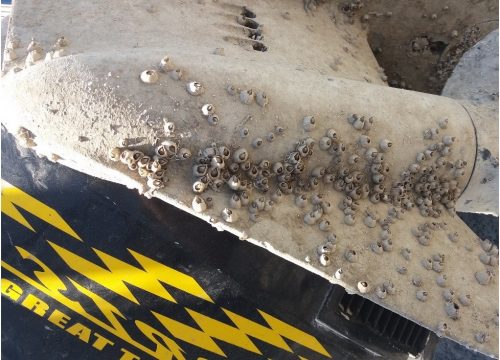The coupling causes a serious problem of increasing the drag of the vessel and slowing down its speed, and a great waste of energy. This phenomenon also causes the change of the ecosystem, due to the transportation of foreign organisms from one port to another in different geographical areas

By: Yossi Cohen
Marine biofouling consists of colonies of organisms such as bacteria, microalgae, algae, fungi, crustaceans and invertebrates, which adhere to the hulls of vessels. The coupling causes a serious problem of increasing the drag of the vessel and slowing down its speed, and a great waste of energy. This phenomenon also causes the change of the ecosystem, due to the transportation of foreign organisms from one port to another in different geographical areas.
The accepted method to prevent the formation of this biological coating on underwater bodies is to paint them with antifouling paints. The main disadvantage of this method is that these paints contain toxic chemical elements such as tin or copper, which are released into the marine environment and harm the flora and fauna there, therefore the use of this type of paint was banned, and scientists began to look for antifoulers, which are also environmentally friendly. Many species of marine algae remain with a clean surface over time thanks to the use of chemical, physical, mechanical, or symbiotic protection techniques.
Inspired by these natural techniques, environmentally friendly engineering solutions were developed for the coupling problem. In this section, we will review the physical and oil techniques:
In the physical protection technique, the development of biofilm on marine algae is prevented mainly thanks to a special topographical structure of their surface. This special structure reduces the contact points that allow the organisms to stick to them. The skin of the shark, for example, is characterized by a microstructure of diamond-shaped grooves, which allow it to both move quickly and prevent the accumulation of biofilm on its skin. Inspired by the skin of the shark, a silicone coating was developed (under the trade name Sharklet) that resembles it in its structure. Applying the Sharklet to underwater surfaces has significantly reduced the accumulation of organisms on their surfaces.
Sealcoat is a commercial antifouling paint, recently developed inspired by seal fur. The Sealcoat contains fibers that simulate the fur of the seal and prevent the formation of a biofilm for a period of about five years.
The Nippon Paint company has developed Hydro-Gel combined with antifouling paint called A-LF-Sea.
This paint gives the vessel's hull a 15% lower friction effect compared to the friction effect with conventional paint, thereby saving about 10% in fuel consumption and significantly lower CO2 emissions. The patent of reducing the friction in the paint A-LF-Sea Developed inspired by the tuna fish, which is able to develop an enormous swimming speed of 100 km/h thanks to the mucous coating that wraps its skin and reduces its friction in the water.
In the next chapter, we will detail the chemical, mechanical and symbiotic methods to prevent the accumulation of coupling for marine vessels.
Source:
- Biomimetic Strategies in Antifouling Coatings by Maria Salta - The Journal of Ocean Tech. Vol. 9, No. 4, 2014
- Can Biomimicry and Bioinspiration Provide Solutions for Fouling Control? By Emily Ralston & Geoffrey Swain - Marine Technology Society Journal - July/August 2011, Vol.45, No.4.
- Akzo Nobel – Int. Marine Coatings - Coatings Tech. - What is fouling?

One response
Thanks for the info, interesting.
More examples of what can be learned from nature and applied:
http://www.asknature.org/